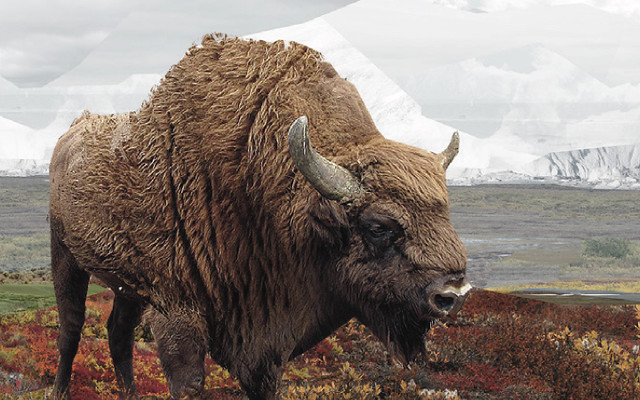Paleontologists have discovered a well-preserved frozen mummy of the extinct Steppe bison (Bison priscus) on the shore of Chukchalakh Lake in Yakutia, Siberia.

The Steppe bison (Bison priscus) by Constantine Flerow, 1989.
The Yukagir bison mummy, as the find was dubbed, has a complete brain, heart, blood vessels and digestive system, although some organs have shrunk significantly over time.
“It is a male about 4-4.5 years old and has an accelerator mass spectrometry radiocarbon date of about 9,300 years before present,” Dr Olga Potapova from the Mammoth Site of Hot Springs in South Dakota and her colleagues reported in a presentation at the 74th Annual Meeting of the Society of Vertebrate Paleontology.
“The Yukagir bison mummy became the third find out of four now known complete mummies of this species discovered in the world, and one out of two adult specimens that are being kept preserved with internal organs and stored in frozen conditions, making this find one of high importance,” Dr Potapova said.

The scientists completed the necropsy of the bison mummy to examine topography, anatomy, and state of the inner organs’ preservation, overall health condition, presence of parasites, cause of death, and to compare it with extinct and extant Bison and Bos taxa.
“The mummy possessed completely preserved inner organs, but some of them were not identified. The organs were removed in four separate parts for the detailed study, tissue sampling, and preservation. The brain represents the first record for the species that appears to be complete,” the scientists said.
“Some torso organs, including trachea, heart with pericardium and large blood vessels, stomach, and penis, appeared to be close to normal sizes.”
“Other inner organs (or their parts), such as the brain, tricuspid and bicuspid heart valves, pulmonary and aorta semilunar valves, papillary muscles, small blood vessels, esophagus, lungs, liver, rumen papillae, reticular crests and cells, omasal laminae, intestines, and left testicle were significantly shrunk.”
“The trachea and lungs didn’t contain foreign objects. The esophagus and rectum were free from food remnants.”
“The rumen and reticulum were filled with vegetation mass containing shrub and tree brunches and roots, while the jejunum contained some chyme.”

Yukagir bison mummy. Image credit: © Academy of Sciences of Republic of Sakha.
“The general topography of the Yukagir bison corresponds to Bison and Bos, but morphology, sizes, and volumes of some organs are largely due to the body’s mummification for thousands of years in permafrost conditions.”
“No visible parasites in the examined organs, pathological tissues, or injury were revealed.”
“The lack of visible subcutaneous fat in the abdomen and neck areas indicates that starvation might have caused the animal’s death.”
Team member Dr Evgeny Maschenko added: “the exclusively good preservation of the Yukagir bison mummy allows direct anatomical comparisons with modern species of Bison and cattle, as well as with extinct species of bison that were gone at the Pleistocene-Holocene boundary.”

The next steps to be done include further examination of the bison’s gross anatomy, and other detailed studies on its histology, parasites, and bones and teeth.
“We expect that the results of these studies will reveal not only the cause of death of this particular specimen, but also might shed light on the species behavior and causes of its extinction,” Dr Potapova said.
Source: sci.news








